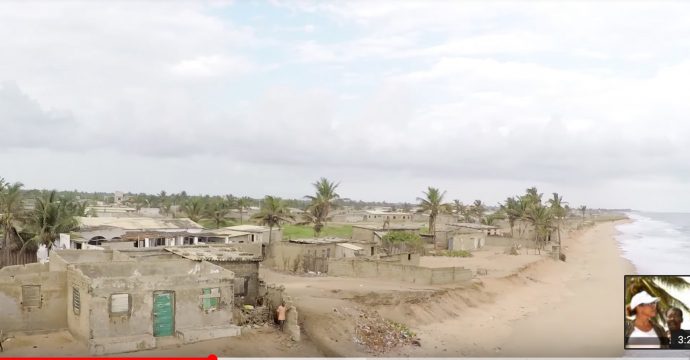WASHINGTON, 9 November 2017: Life is shifting fast for coastal communities in West Africa. In some areas, coastlines are eroding as much as 10 meters per year. Stronger storms and rising seas are wiping out homes, roads and buildings that have served as landmarks for generations.
I was recently in West Africa to witness the effects of coastal erosion. To understand what’s going on, we took a three-country road trip, traveling from Benin’s capital Cotonou, along the coast to Lomé in Togo and then to Keta and Accra in Ghana.
These three countries, among the hardest hit by coastal erosion, offer a snapshot of what is happening along the rest of the coast, from Mauritania, via Senegal to Nigeria.
On more than one occasion, we would be talking with local people who said: “Do you see those boats out there? That’s where my house used to stand.”
With their homes swept out to sea and fishing limited, people have no choice but to move away to make a living.
This trend is breaking up communities and changing the social fabric for large numbers of people, possibly millions in the future.
Aside from the human dimension, why are we so focused on coastal erosion?
First, it has a detrimental, measurable impact on the economic and social development of our client countries.
Second, while climate change is making it worse, coastal erosion is partially man-made and could be slowed down and managed more effectively, particularly if we take a regional approach.
13 millioner mennesker
The economic and social impact of coastal erosion was strongly evident on our trip.
About 13 million people who live in cities and villages in the coastal areas between Mauritania and Gabon have been affected by coastal erosion and flooding in the past 17 years.
Their livelihoods are wrapped up in everything along the coast — from farming, to fishing and marine industries to tourism, agro-industries and off-shore oil.
Country investment in public infrastructure along the coast can be risky and the benefits short-lived.
For example, one piece of the Abidjan-Lagos highway in Togo – a vital artery for economic development and integration in West Africa – has already been rebuilt twice – every time further inland.
Hotels and entire fishing villages have been swallowed up by encroaching waters, imposing high costs on both the state, communities and individuals.
At the current rate of erosion, there is also little appetite to invest in tourism infrastructure.
Coastal infrastructure – especially ports, but also groynes (høfder. red.) and jetties, capture sand so that beaches further down the coast don’t get replenished.
Moreover, large dams that capture sediment which would have otherwise made its way to the shore, withdraw ‘beach building material’. Sand mining in rivers or along beaches aggravate the problem.
Regionale løsninger er nødvendige
We need a regional approach to this problem. On the West African coast, ocean currents go from north to south and west to east, so whatever is done upstream has an effect downstream.
Policies and actions taken by one country can have an immediate – and sometimes detrimental – impact on a neighbor.
For instance, we witnessed the impact that the port of Lomé, which was built in the 1960s, and measures undertaken to protect the city of Aneho in Togo, have had on the coast of Togo and Benin.
But we also saw how Ghana’s efforts to replenish its beaches by building groynes in a targeted manner, have paid off and reconstituted some areas.
The same has happened in Cotonou. The lesson here is that coastal erosion needs to be approached in a more holistic way and countries must work together as they try to maintain their shoreline, livelihoods and communities.
A multi-disciplinary approach is also needed across the World Bank Group and in our efforts with the private sector.
That’s why we are building a program that can support West African countries to strengthen the resilience of coastal communities to climate and other hazards.
Called the West Africa Coastal Areas management program(WACA), it could support up to 17 West African countries to improve the management of shared natural and man-made risks affecting targeted coastal communities.
The program, with its mix of technical assistance and investments, will reduce risk to millions of people.
Paris-erklæringen
All of this takes place against a backdrop of our strong commitment to combat the effects of climate change, which in the form of sea level rise, more extreme weather and stronger ocean currents is a major contributor to coastal erosion.
It also underscores our determination to work closely with countries to meet their commitments made under the Paris Agreement to keep temperature rise below 2 degrees Celsius.
I attended the Our Ocean Conference in Malta last month, convened by the European Commission, where the challenges of how to integrate ocean and coastal zone management, how to make fisheries more sustainable and how to bring about more multi-sector and stakeholder cooperation were at the forefront of our discussions.
Those discussions on how to maximize what we call the Blue Economy, continue this week at COP23 in Bonn.
What I saw in West Africa underscores the urgency of our efforts.














